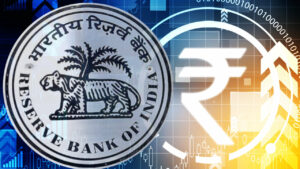In the Union Budget 2022 speech, Finance minister Nirmala Sitharaman announced that RBI (Reserve Bank of India) will be issuing Central Bank-backed Digital Currency (CBDC), its own digital currency in the new financial year 2022-23. Through the use of blockchain technology, fiat currency will be transacted digitally.
The sovereign or central bank (as its representative) is the issuer of currency. Currency is fiat and a legal tender. It is a liability for the central bank and an asset in the hands of the public.
What is a CBDC?
CBDC, Central Bank-backed Digital Currency, is a legal tender in digital form. The digital rupee is the same as fiat currency but in a different form. It is a sovereign currency in an electronic form which would be a liability in RBI’s balance sheet. The digital currency in circulation at par with the physical currency but in digital form and is exchangeable with fiat currency.
RBI will use blockchain and other technologies to introduce digital rupee, giving a boost to the digital economy. It will fulfil all the basic functions such as medium of exchange, store of value, unit of account, and standard of deferred payment (legal tender).
The use of blockchain technology will ensure anonymity thereby retaining transparency and authenticity of the ledger. It will have a unique serial number for identification purposes.

Need for a CBDC
According to a 2021 BIS survey of central banks, only 86% were researching about the potential of CBDCs, 60% were experimenting with the technology, and only 14% went beyond the pilot stage (China, South Korea, etc.). Only 9 countries have fully launched digital currency (like the Bahamas), Nigeria, the latest one, launched e-Naira. So, the reasons for the sudden interest in digital currency are:
- Firstly, Central banks are facing dwindling usage of paper currency. Hence, they want to popularize a more acceptable electronic form of currency.
- Secondly, jurisdictions seek to make digital payments more efficient.
- Lastly, most importantly, central banks want to address the demand for digital currency and avoid the damaging consequences of private virtual currencies.
In India, the increased proliferation of digital payments, even for small-value transactions, prompted RBI to have digital currency. CBDC will not replace cash usage but will help to reduce the cost of printing, transporting, storing and distribution of paper currency.
Difference between CBDC and Cryptocurrency
Private virtual currencies are decentralized and have no intrinsic value because they are not commodities. On the other hand, CBDC is centralized and has an issuer. Also, cryptocurrencies are not a representation of any person’s debt or liabilities whereas CBDC is the liability of the central bank. Additionally, digital currency does not legitimize cryptocurrency transactions.
How does CBDC affect banks?
CBDCs can cause dislocations depending on their design. They can reduce transaction demand for bank deposits but also reduce settlement risks. Also, they are risk-free which will help to cut government guarantees on bank deposits. Banks will lose their ability to create credit if the deposits reduce.
Benefits of CBDC over other digital payment systems
CBDC payments are final and reduce settlement risks. Just imagine a UPI system where CBDC is used to make payments instead of bank balances, as if one is handing over cash. It will reduce the need for interbank settlements. Digital currency will enable cost-effective and real-time globalization of payment systems. For example- an Indian importer can pay its American exporter in digital dollars on real-time basis without any intermediary. The transaction will be final, as if physical dollars, without the participation of the Fed Reserve for settlement. The ‘time difference’ factor will get eliminated in the case of currency settlement.
Other benefits offered by CBDC are in terms of liquidity, scalability, ease of transactions with anonymity, acceptance, and faster settlement. The adoption and accessibility will improve the support of government infra. Experts expect that RBI will leverage the existing system through NPCI and QR codes for faster acceptance and adoption of digital currency.
What is RBI Planning?
The RBI is examining various cases and working out on phased implementation manner with little or no disruption. In order to launch digital currency, it is crucial to understand the design and usage of digital currency. It is also working on retail and wholesale models use of CBDC.
The launch won’t happen before the crypto law is passed in the parliament. It requires amendments to various acts- the RBI Act, the Coinage Act, the FEMA, and the Information Technology Act since the existing provisions were created for paper currency.

Digital rupee will save operational costs for RBI
Digital currency will help RBI to save printing, storing, distribution, and transporting costs of paper currency. For every ₹100 note, the cost is ₹15- 17 in its four-year cycle. The cycle starts from printing new notes to soiled notes coming back to the central bank via commercial banks.
The withdrawal of higher denomination notes has led to the printing of smaller denomination notes in large quantities. CDBC will help to save significant costs. CBDC, a revamped version of physical currency, will eventually reduce the cost of currency management.
In the last financial year, RBI printed about 1.49 lakh additional notes as the cash circulation in the economy increased. The total cash circulation was ₹28.32 lakh crores as of 31st March 2021. Considering the numbers, the currency management cost will come down significantly by hundreds of crores of rupees.
If RBI uses a centralized approach where a customer has to open an account to use CBDC, net saving costs will be notable.
Electronic platforms of currency become efficient in high physical cash usages countries like India. They could also act as a substitute for private virtual currencies.
Blockchain technology for CBDC
Blockchain might not be the ideal technology for issuing CBDC because it requires massive power consumption, which is more in a country like India with a 1.3 billion population.
Instead, RBI can either offer the digital rupee directly to the citizens or use the retail indirect method- issue currency to banks, who in turn offer it to the citizens.
Blockchain technology has massive power consumption, settlement time is higher and has permission issues. There could be an arrangement where RBI and banks use blockchain technology, but later banks use different technology to transact with customers.
This opens opportunities for other technologies. CBDC will run on India’s public digital infrastructure- UPI (Unified Payments Interface) and universal identification Aadhar number. This will enable real-time eKYC (through Aadhar) and automatic money transfer (via UPI model).
Experts believe that India is the best place to launch a CBDC due to the rapid adoption of digital banking and e-payments. This will lead to financial inclusion.
There are doubts over the feasibility of CBDC in 2022-23. Initial operationalization will likely be for B2B and B2G payments, as it is difficult to push citizens to use digital wallets within the time frame.
Additionally, there are multiple design considerations to look after, like- will RBI use CDBC for specific use only, will RBI manage it directly or through intermediaries, will RBI also look after KYC, will it offer interest, and whether transactions are anonymous or not.

Conclusion
To sum up, the digital rupee can have various uses such as programmable payments for subsidies and use by financial institutions for faster payments. We will observe a pragmatic shift to a cashless economy shortly. With the increase in usage of digital currency, various other benefits can be reaped like cross-border remittances, interoperable environment, faster real-time settlements, a reduction in government and business costs, etc.
For example- In UAE, a worker received 50 % of the salary as digital money, allowing a person to send that money to relatives in any other country cheaply and efficiently. Fess for wiring money often rises to 7% of the transaction value. The World Bank estimates that cutting the fee by 2% could give $16 billion a year impetus to remittances to low-income nations.





